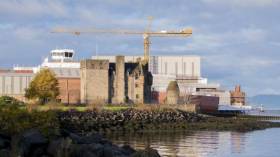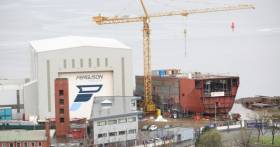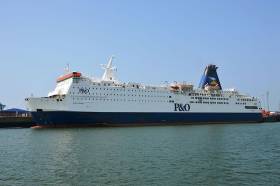Displaying items by tag: Scottish Government
Ferry Fares at CalMac Could Rise up to 40 % for Visitors to Islands Under Scottish Government Review
Ferry operator, Caledonian MacBrayne (CalMac) owned by the Scottish Government, could face an increase in fares for visitors to west coast islands as part of a major government review amid rising demand and costs.
According to newly-published proposals, suggest that a reduction in ferry fares by ministers made almost a decade ago to bring them into line with road travel costs, could be reversed for all users with the exception of island residents.
The development came as yet another delay to the hugely-late newbuild hybrid-powered ferry Glen Sannox, was signalled by Clyde based shipbuilder Ferguson Marine, which said its completion could be postponed beyond the latest delivery date set for May.
The Port Glasgow based shipyard cited the delay of the 102m ferry, originally to enter service in 2018 on the Isle of Arran route, was because of problems getting parts for the ferry’s novel dual-fuel system.
In response to the shipyard’s revised delivery date, the Scottish Government has described the announcement as “concerning and extremely disappointing”.
A review of west coast island ferry fares, is a plan that Ministers intend to examine, as part of a new strategy for links to the islands. This follows reduced ticket prices that led to a surge in demand and consequently resulted in overwhelming some routes at already busy peak times.
For more, The Scotsman reports, including reduced fares also applied since 2018 to Scottish east coast ferry firm, NorthLink (operated by Serco) serving Orkney and the Shetland Isles.
In Scotland, ministers of the Government intend to return the troubled shipyard of Ferguson Marine to the private sector, a senior Scottish National Party minister has confirmed.
The SNP minister Neil Gray and Cabinet Secretary for Wellbeing Economy, Fair Work and Energy, said it was hoped the shipyard (located downriver of Glasgow at Port Glasgow) could become commercially successful again.
Ferguson Marine as Afloat has reported over the years, has been at the centre of controversy over the construction of two newbuild ferries for CalMac, a subsidiary of David MacBrayne Ltd, which is wholly owned by Scottish Ministers.
The first of the two newbuilds of around 5,000 gross tonnage, the Glen Sannox and an unnamed twin are substantially delayed and overbudget.
Each of the 102m ferries have a capacity for 1,000 passengers, 127 cars and 16 lorries that are to serve island communities and tourism.
In March a report by Audit Scotland had raised doubts over the long-term viability of the shipyard, which was to have completed building the first of the ferries in 2018 at the yard that in the following year was nationalised.
For more, The Scotsman reports.
In a decision by the Scottish government it is "ready and willing" to take Ferguson shipyard into public ownership, Economy Secretary Derek Mackay has announced.
As BBC News reports, the minister said this was to avert the yard's closure with the loss of 350 jobs, and to complete two ferries being built there for Cal Mac west coast services.
The move follows legal notice being served that the business faces administration by the end of this week.
Mr Mackay said the government remained open to other investors.
But in a statement, he added that it was essential to act without delay, to secure the yard, its workforce and the unfinished ships.
A letter has been sent to Ferguson Marine, and its sole shareholder, industrialist Jim McColl, saying the Scottish government is hopeful that directors and creditors "recognise the importance of completing that transfer as quickly and smoothly as possible".
More here on the shipyard story.
Scottish Government Rejects Offer of Stake in Clyde Shipyard
Jim McColl has failed to convince the Scottish Government to take a stake in the last commercial shipyard on the Clyde.
The near-billionaire, The Herald writes, was understood to be ready to take a multi-million-pound “hit” on his investment at Ferguson Marine in Port Glasgow.
And this week he convinced Labour and SNP local to back his scheme in the hope of securing 350 jobs after their current contracts to make ferries ran in to cost over-runs and contractual disputes.
Ministers consider nationalising shipyard owned by billionaire adviser to Nicola Sturgeon (click here for more).
The Herald understands Mr McColl and his Clyde Blowers Capital or CBC felt they had legal advice that assuaged concerns by civil servants over an equity partnership.
However, a Scottish Government spokesman said: “We share the determination to ensure a strong, long term future for Fergusons.
For more click here including a related article on the yard which predicts a loss of £44m on a pair of newbuild dual-fuel ferries for CalMac.
#FerryNews - According to the Edinburgh News, a ferry company has said it is willing to enter talks with the Scottish Government about a new ferry route between Scotland and Scandinavia.
P&O Ferries said it was “always looking for new opportunities” after SNP backbench MSP Angus MacDonald urged Transport Minister Humza Yousaf to call a summit with ferry operators to explore the potential for a new service between Scotland and Norway, Denmark or Sweden.
Rosyth’s freight-only ferry to Zeebrugge is currently the country’s only sea link to Europe. But a new passenger ferry to Scandinavia is seen as an opportunity to boost exports as well as tourism.
Mr MacDonald said a new ferry link could be “incredibly beneficial” to Scotland and he hoped a meeting with ferry operators could be arranged “ahead of the potential damage to our tourism sector from the impact of Brexit”.
A spokesman for P&O said: “We are always looking for new opportunities and would be happy to sit down with the relevant parties to discuss a route between Scotland and Scandinavia.”
There were more than 15 million visits to the UK from Scandinavia between 2011 and 2016, contributing nearly £8.5 billion to the UK economy. Spending by Danish visitors alone rose by 30 per cent over the five years.
In 2016, Sweden, Denmark and Norway ranked 14th, 15th and 16th for the number of visitors coming to the UK. Mr MacDonald said: “Surely it makes sense to give people another option of how to travel across the North Sea, to ensure our economy continue to benefit from tourists?”
The ferry route between Rosyth and the Belgian port of Zeebrugge opened in 2002, but the passenger service ended in 2010 and it has since been freight-only.
Mr MacDonald said the last ferry link from the UK to Scandinavia ended in 2014 which Afloat previously reported on was DFDS Seaways Harwich-Esbjerg service.
To read more on this story, click here and Afloat's piece on P&O's 180th anniversary which was marked last year.































































